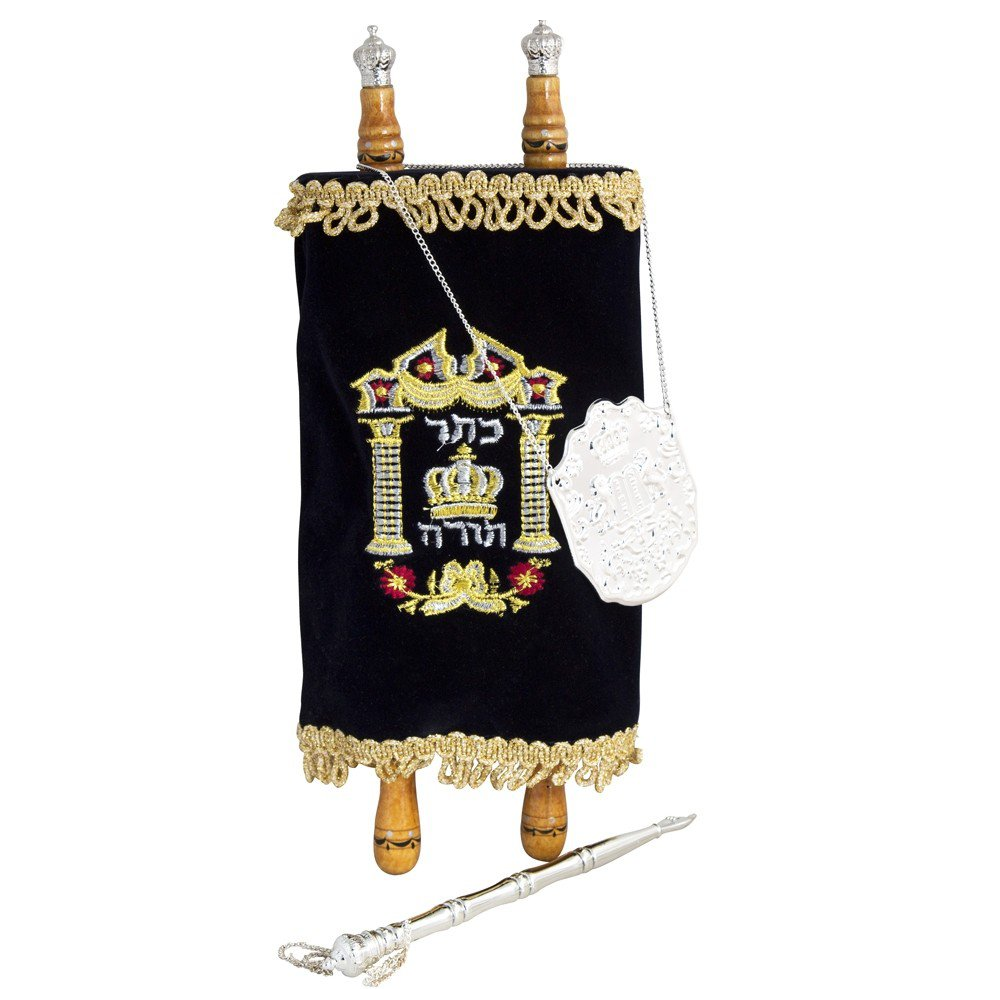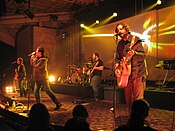|
Weekly Parashah |
|||||
| Torah: Genesis 44 : 18 – 47 : 27 | Haftara: Eze. 37:15–28 | Brit Chadashah: Jn. 5:1–47 Matt. 1:18-2:12 Luke 1:16-2:20 |
|||
| Vayigash (and he drew near) וַיִּגַּשׁ |
|||||
Scripture: |
Genesis 44 : 18 – 47 : 27 |
Torah |
|||
|
|
Judah Pleads for Benjamin18 Then Judah approached him and said, “I beg your pardon, my lord. Please let your servant say a word in my lord’s ears, and don’t be angry with your servant, since you are like Pharaoh. 19 My lord asked his servants saying, ‘Do you have a father or a brother?’ 20 So we said to my lord, ‘We have a father who is old, a child born to him of his old age is young. Now his brother is dead, so he is the only one of his mother’s children left, and his father loves him.’ 21 Then you said to your servants, ‘Bring him down to me so that I can look at him.’ 22 But we said to my lord, ‘The boy cannot leave his father. If he were to leave his father, he would die.’ 23 Then you said to your servants, ‘Unless your youngest brother comes down with you, you won’t see my face again.’ https://www.biblegateway.com/passage/?search=Gen.+44%3A18%E2%80%9347%3A27&version=TLV |
||||
Scripture: |
Ezekiel 37:15–28 |
Haftarah |
|||
Reunification of Southern and Northern Kingdoms15 The word of Adonai came to me saying: 16 “You, son of man, take one stick and write on it, ‘For Judah’—for Bnei-Yisrael joined with him. Then take another stick and write on it, ‘For Joseph’—the stick of Ephraim and all the house of Israel joined with him. 17 Join them one to another for yourself, as one stick, so they may become one in your hand. https://www.biblegateway.com/passage/?search=Eze.+37%3A15%E2%80%9328&version=TLV |
 |
||||
Scripture: |
Jn. 5:1–47
|
Brit Chadashah |
|||
|
|
5 After this there was a Jewish feast, and Yeshua went up to Jerusalem. 2 Now in Jerusalem there is a pool by the sheep gate, called Bethzatha in Aramaic,[a] which has five porches. 3 In these a crowd of invalids was lying around—blind, lame, disabled. (4 )[b] https://www.biblegateway.com/passage/?search=Jn.+5%3A1%E2%80%9347&version=TLV Matthew 1 : 18 – 2 : 12The Miraculous Birth of Yeshua18 Now the birth of Yeshua the Messiah happened this way. When His mother Miriam was engaged to Joseph but before they came together, she was found to be pregnant through the Ruach ha-Kodesh. 19 And Joseph her husband, being a righteous man and not wanting to disgrace her publicly, made up his mind to dismiss her secretly. 20 But while he considered these things, behold, an angel of Adonai appeared to him in a dream, saying, “Joseph son of David, do not be afraid to take Miriam as your wife, for the Child conceived in her is from the Ruach ha-Kodesh. 21 She will give birth to a son; and you shall call His name Yeshua, for He will save His people from their sins.”22 Now all this took place to fulfill what was spoken by Adonai through the prophet, saying, 23 “Behold, the virgin shall conceive and give birth to a son, and they shall call His name Immanuel,” which means “God with us.”[a]24 When Joseph woke up from his sleep, he did as the angel of Adonai commanded him and took Miriam as his wife. 25 But he did not know her intimately until she had given birth to a Son. And he called His name Yeshua. Wise Men Follow His Star2 Now after Yeshua was born in Bethlehem of Judea, in the days of King Herod, magi from the east came to Jerusalem, 2 saying, “Where is the One who has been born King of the Jews? For we saw His star in the east and have come to worship Him.”[b] https://www.biblegateway.com/passage/?search=Matt.+1%3A18-2%3A12&version=TLV Luke 1 : 16 – 2 : 2016 Many of Bnei-Yisrael will turn to Adonai their God. 17 And he will go before Him in the spirit and power of Elijah, to turn the hearts of fathers to the children[a] and the disobedient ones to the wisdom of the righteous, to make ready for Adonai a prepared people.18 Zechariah said to the angel, “How will I know this for certain? I’m an old man, and my wife is well-advanced in age.”19 And speaking to him, the angel declared, “I am Gabriel, the one standing in God’s presence. I was commissioned to tell you and proclaim to you this good news. 20 So look, you will be silent and powerless to speak until the day these things happen, since you did not believe my words which will be fulfilled in their time.” 21 The people were waiting for Zechariah and wondering about his long delay in the Holy Place. 22 But when he came out, he couldn’t speak to them. Then they realized that he had seen a vision in the Holy Place. He was making signs to them but remained mute. 23 When the days of his priestly service had been completed, he went home. 24 After these days, his wife Elizabeth became pregnant and hid herself for five months, saying, 25 “Adonai has done this for me! In these days He looked upon me, to take away my disgrace among the people.”[b] Prophecy of Birth to the Virgin26 Then in the sixth month, the angel Gabriel was sent by Adonai into a town in the Galilee named Natzeret 27 and to a virgin engaged to a man named Joseph, of the house of David. The virgin’s name was Miriam. 28 And coming to her, the angel said, “Shalom, favored one! Adonai is with you. https://www.biblegateway.com/passage/?search=Luke+1%3A16-2%3A20&version=TLV |
||||
Parashah in 60 seconds |
|||||
Music Styles Christian Rock
Styles
On this radio station you will find the following music styles;
Christian Rock
Within EWCMI Online Radio we mark Christian rock is the form and styles of rock music that promotes Jesus and is typically performed by self-proclaimed Christian individuals and bands whose members focus the lyrics on matters of Christian faith.
The extent to which their lyrics are explicitly Christian varies between bands.
History
Christian response to early rock music (1950s–1960s)
Rock music was not viewed favorably by most traditional and older Christians when it became popular with young people from the 1950s, although early rock music was often influenced by country and gospel music.
Religious people in many regions of the United States did not want their children exposed to music with unruly, impassioned vocals, loud guitar riffs and jarring, hypnotic rhythms. Rock and roll differed from the norm, and thus it was seen as a threat.[1] Often the music was overtly sexual in nature, as in the case of Elvis Presley, who became controversial and massively popular partly for his suggestive stage antics and dancing.
However, Elvis was a religious person who even released a gospel album: Peace in the Valley.[2]
In the 1960s, rock music developed artistically, attained worldwide popularity and became associated with the radical counterculture, firmly alienating many Christians. In 1966 The Beatles, regarded as one of the most popular and influential rock bands of their era, ran into trouble with many of their American fans when John Lennon jokingly offered his opinion that Christianity was dying and that the Beatles were "more popular than Jesus now".[3][4]
The romantic, melodic rock songs of the band's early career had formerly been viewed as relatively inoffensive, but after the remark, churches nationwide organized Beatles record burnings and Lennon was forced to apologize.[5] Subsequently, the Beatles and most rock musicians experimented with a more complex, psychedelic style of music, that frequently used anti-establishment, drug related, or sexual lyrics, while The Rolling Stones sang "Sympathy for the Devil", a song openly written from the point of view of Satan.
This further increased the Christian opposition to rock music.
Countless new bands sprang up in the mid-to-late 1960s, as rock displaced older, smoother pop styles to become the dominant form of pop music, a position it would enjoy almost continuously until the end of the 20th century, when hip-hop finally eclipsed it in sales.
Roots (late 1960s–1980s)
Among the first bands that played Christian rock was The Crusaders, a Southern Californian garage rock band, whose November 1966 Tower Records album Make a Joyful Noise with Drums and Guitars is considered one of the first gospel rock releases,[6] or even "the first record of Christian rock",[7] and Mind Garage, "arguably the first band of its kind",[8] whose 1967 Electric Liturgy was recorded in 1969 at RCA's "Nashville Sound" studio.[9]
Larry Norman, often described as the "father of Christian rock music",[10] and in his later years "the Grandfather of Christian rock",[11] who, in 1969 recorded and released Upon This Rock, "the first commercially released Jesus rock album",[12] challenged a view held by some conservative Christians (predominantly fundamentalists) that rock music was anti-Christian. One of his songs, "Why Should the Devil Have All the Good Music?" summarized his attitude and his quest to pioneer Christian rock music.[13]
A cover version of Larry Norman's Rapture-themed "I Wish We'd All Been Ready" appears in the Evangelical Christian feature film A Thief in the Night and appeared on Cliff Richard's Christian album Small Corners along with "Why Should the Devil Have All the Good Music?".
Another Christian rock pioneer, Randy Stonehill, released his first album in 1971, the Larry Norman-produced Born Twice.[14][15] In the most common pressing of the album, side one is entirely a live performance.[16]
Christian rock was often viewed as a marginal part of the nascent Contemporary Christian Music (CCM) and contemporary gospel industry in the 1970s and '80s,[19] though Christian folk rock artists like Bruce Cockburn and rock fusion artists like Phil Keaggy had some cross-over success.
Petra and Resurrection Band, two of the bands who brought harder rock into the early CCM community, had their origins in the early to mid-1970s.
They reached their height in popularity in the late eighties alongside other Christian-identifying hard rock acts such as Stryper. The latter had videos played on MTV, one being "To Hell with the Devil", and even saw some airtime on mainstream radio stations with their hit song "Honestly".
Christian rock has proved less successful in the UK and Europe, although such artists as Bryn Haworth have found commercial success by combining blues and mainstream rock music with Christian themes.
1990s–present
The 1990s saw an explosion of Christian rock.
Many of the popular 1990s Christian bands were initially identified as "Christian alternative rock", including Jars of Clay, Audio Adrenaline and the later albums of dc Talk. Outside Anglophone countries, bands like Oficina G3 (Brazil) and The Kry (Quebec, Canada) have achieved moderate success. To date Delirious? has been one of the most successful bands from the UK.
By the late 1990s and early 2000s, the success of Christian-inspired acts like Skillet, Thousand Foot Krutch, Decyfer Down, Underoath, Kutless, Disciple and Relient K saw a shift toward mainstream exposure in the Christian rock scene.
Among popular Christian rock bands of the first decade of the 21st century that exemplified this trend were RED and Fireflight.
There are also some Roman Catholic bands such as Critical Mass. Some Eastern Orthodox Christian rock groups, mostly from Russia and the Soviet Union, started performing in the late 1980s and 1990s. Alisa[20] and Black Coffee[21] are credited as the most prominent examples. The Orthodox Christian lyrics of these bands often overlap with historical and patriotic songs about ancient Rus. Christian rock is on the rise in the Russian music underground in 2000s, and Orgia Pravednikov[22] is one of the most notable happenings.
The musical genre that was once rejected by mainstream Christian churches is now considered by some as one of the most-important recruitment tool of their successor congregations.
According to Terri McLean, author of New Harmonies, old-guard churches (United Methodist is given as an example) of the late 1990s were experiencing a rapid decline in membership and were under threat of disbandment within the next decade, a trend that has been going on since the 1980s.[23] McLean, using numerous quotes from theologians, Christian apologists and professors, goes on to offer contemporary Christian music as the reason for the falling popularity of more traditionalist churches.[24]
The definition of contemporary Christian, as offered by New Harmonies, is of a genre not far removed from traditional hymns; it is simply more accessible. The reality is that while a form of modernized hymns do exist in today's churches and do have an impact on church recruitment, there also exists both within and outside these churches a form of music (Christian rock) that has only one element in common with previous religious genres: its worship of God.
This element, the worship of God, is what was originally removed from or hidden within the lyrics of early, secular rock n' roll.
Santino described one method of changing Christian lyrics as a process that transformed “lyrics that sang of the mystical love of God into lyrics that celebrated the earthly love of woman”.[25]
Howard & Streck offer examples of this, comparing Ray Charles' “This Little Girl of Mine” to “This Little Light of Mine” and “Talking About You” to “Talking About Jesus”. They claim that because of actions such as this, despite the liberal editing of the original hymns, “gospel 'showed rock how to sing'”.[26] Howard & Streck go on to describe how the conflict between music and religion, spearheaded by southern fundamentalists, was originally racially based, but how in the sixties this moved on to a clash over the perceived lifestyle of rock musicians.[27]












